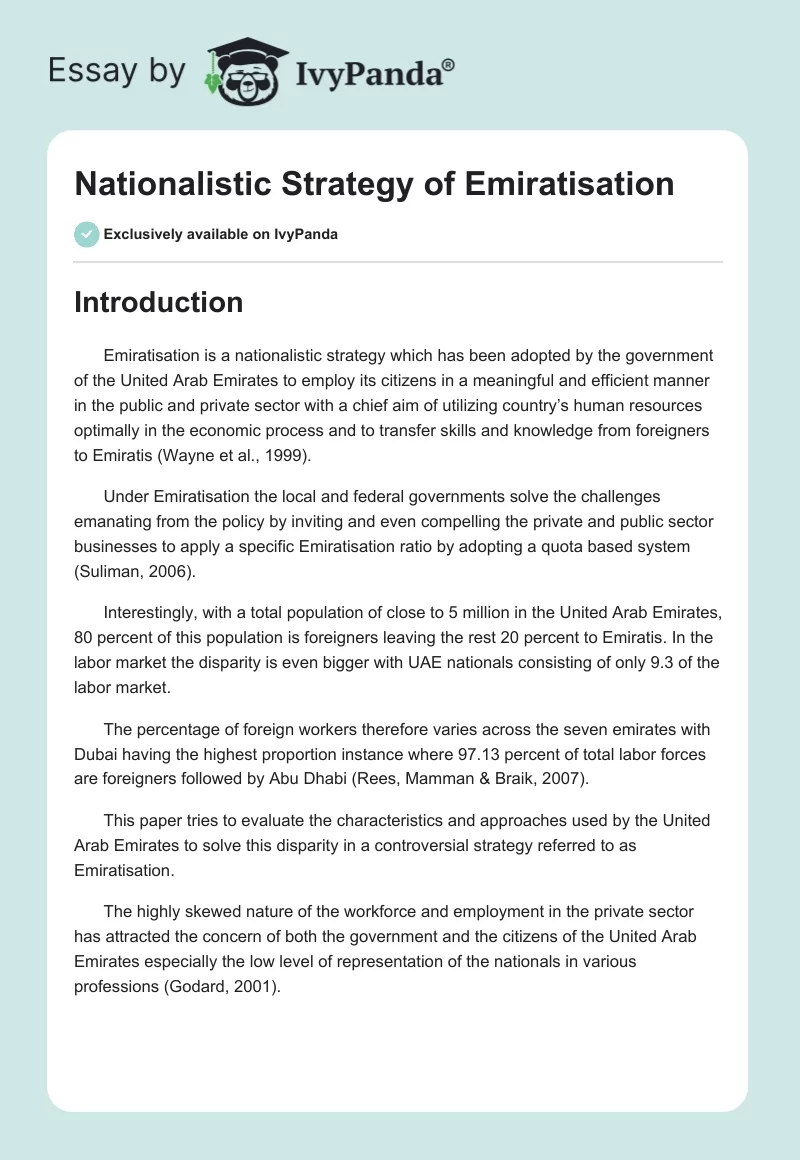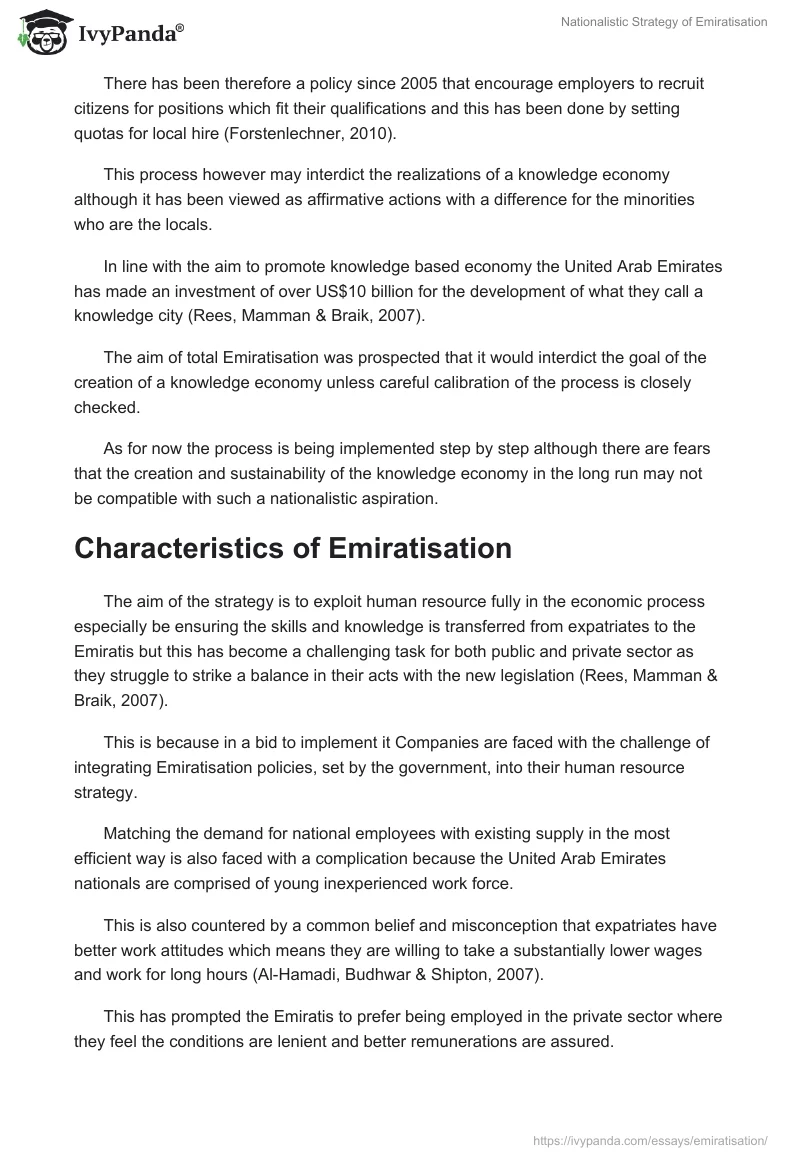Introduction
Emiratisation is a nationalistic strategy which has been adopted by the government of the United Arab Emirates to employ its citizens in a meaningful and efficient manner in the public and private sector with a chief aim of utilizing country’s human resources optimally in the economic process and to transfer skills and knowledge from foreigners to Emiratis (Wayne et al., 1999).
Under Emiratisation the local and federal governments solve the challenges emanating from the policy by inviting and even compelling the private and public sector businesses to apply a specific Emiratisation ratio by adopting a quota based system (Suliman, 2006).
Interestingly, with a total population of close to 5 million in the United Arab Emirates, 80 percent of this population is foreigners leaving the rest 20 percent to Emiratis. In the labor market the disparity is even bigger with UAE nationals consisting of only 9.3 of the labor market.
The percentage of foreign workers therefore varies across the seven emirates with Dubai having the highest proportion instance where 97.13 percent of total labor forces are foreigners followed by Abu Dhabi (Rees, Mamman & Braik, 2007).
This paper tries to evaluate the characteristics and approaches used by the United Arab Emirates to solve this disparity in a controversial strategy referred to as Emiratisation.
The highly skewed nature of the workforce and employment in the private sector has attracted the concern of both the government and the citizens of the United Arab Emirates especially the low level of representation of the nationals in various professions (Godard, 2001).
There has been therefore a policy since 2005 that encourage employers to recruit citizens for positions which fit their qualifications and this has been done by setting quotas for local hire (Forstenlechner, 2010).
This process however may interdict the realizations of a knowledge economy although it has been viewed as affirmative actions with a difference for the minorities who are the locals.
In line with the aim to promote knowledge based economy the United Arab Emirates has made an investment of over US$10 billion for the development of what they call a knowledge city (Rees, Mamman & Braik, 2007).
The aim of total Emiratisation was prospected that it would interdict the goal of the creation of a knowledge economy unless careful calibration of the process is closely checked.
As for now the process is being implemented step by step although there are fears that the creation and sustainability of the knowledge economy in the long run may not be compatible with such a nationalistic aspiration.
Characteristics of Emiratisation
The aim of the strategy is to exploit human resource fully in the economic process especially be ensuring the skills and knowledge is transferred from expatriates to the Emiratis but this has become a challenging task for both public and private sector as they struggle to strike a balance in their acts with the new legislation (Rees, Mamman & Braik, 2007).
This is because in a bid to implement it Companies are faced with the challenge of integrating Emiratisation policies, set by the government, into their human resource strategy.
Matching the demand for national employees with existing supply in the most efficient way is also faced with a complication because the United Arab Emirates nationals are comprised of young inexperienced work force.
This is also countered by a common belief and misconception that expatriates have better work attitudes which means they are willing to take a substantially lower wages and work for long hours (Al-Hamadi, Budhwar & Shipton, 2007).
This has prompted the Emiratis to prefer being employed in the private sector where they feel the conditions are lenient and better remunerations are assured.
Moreover, in trying to integrate and attract UAE nationals and secure knowledge transfer from expatriates to UAE nationals the private sector usually engage themselves in Emiratisation activities such as recruitment fairs, training programmes and corporate university involvement (Wayne et al., 1999).
Most of these engagements are costly and there are doubts whether they will ever pay off. In the attempt to retain Emirati staff in the workplace there are some common themes for both private and public organisations which also characterize Emiratisation strategy and some of the challenges are common.
There are challenges such as insensitivity of the management to cultural differences (O’Reilly and Chatman, 1986).
Since most of the managers and top ranking staff in both private and public sector are expatriates it became difficult for the management to tolerate the culture of Emirati nationals especially when it came to disciplining and issuing out duties.
The culture change also included unpopular shift schedules and uniforms which the emirates are not used to and this brings a lot of complains in the work place and hence compromising human resource relation and performance in general.
Another characteristic is a situation where the Emirati nationals lack a coaching and mentoring culture and therefore it is very difficult to manage and sustain skills required by the employer (Forstenlechner, 2010).
Emiratisation is also marked by the reluctance of the Emirati nationals to work for long hours and within some set schedules since they were assured of jobs and the government protects their employability.
Another characteristic of Emiratisation is high expectations of job promotion by the emirates because the government has decreed that there should be a balance in the workplace ratio but most these nationals lack the required skills and training to fit in the higher posts (O’Reilly and Chatman, 1986).
Other challenges that face Emiratisation include but not limited to lack of performance based culture, the manager’s negative behavior, lack of teamwork collaboration, lack of performance-based culture and family pressures (O’Reilly and Chatman, 1986).
Immediately after its inception the strategy was rendered lame by a myriad challenges but there have been concern to seek ways of having it successfully implemented while trying to maintain the UAE investors as well as preparing the prerequisite skills among the nationals.
Approaches to Emiratisation
However there have been efforts by both the government and the employment sector to correct these challenges in order to achieve the goals of Emiratisation strategy in the United Arab Emirates and several approaches have been adopted.
The first approach is that of motivation where is was realized that for the Emiratisation strategy to work Emiratis have to be motivated so as to be retained in the workplace and this can be done through some strategies like aligning the company goals with those of the employees (Wayne et al.,1999).
This can be done also by designing the organization in a way that reflect key factors that will enable to boost organisations’ retention of high performing nationals and ensuring that the human resource team match their activities to delivering a highly motivated and performing work force.
Another strategy is to assess the culture system and individual needs of the organization and ensuring that the expectations of the organization are set right from the beginning and this will enable the Emiratis to be aware of what is expected of them (O’Reilly and Chatman, 1986).
Further communication among the personnel managers and the workers are encouraged in an honest way so as to change the attitude of both and this can be strengthened by creating clear goals, objectives and expectations whereby employees are encouraged to participate in such initiatives.
Other strategies are aimed at; creating a recognition culture and rewarding high performers, offering coaching or mentoring for support and encouragement as well as implementing a strong learning strategy to expand knowledge through further education and development (Rees, Mamman & Braik, 2007).
Finally there is an established systematic working to improve employee motivation and this helps organisations to reach Emiratisation targets and improve retention rates.
There are therefore three approaches that are used in Emiratisation strategy in order to ensure that the mentioned challenges are solved and Emiratisation strategies are successful.
Employee Assessment
Employee assessment is done before entering into a role within any organization whereby the employee goals are put in line with those of the organization. This is done in order to ensure that the person to be employed meets the requirements of the position both academically and skill wise (Rees, Mamman & Braik, 2007).
In this assessment the employer is also required to ensure that the employee has grasped the expectations of the organization because this will ensure that there will be less conflict in the work place.
In Emiratisation this assessment criteria is an approach which when met in advance of recruitment organisations are expected to obtain the best qualified candidates and fosters confidence that they have the right people in the right positions (Al-Hamadi, Budhwar & Shipton, 2007).
Career Guidance and Counseling
Career guidance and counseling is a key success factor that is expressed by many organisations on retaining Emiratis in the work place because it gives career directed progress that provides a path for further development.
The approach is tested and considered to be the best for joining and staying at any organization operating in the United Arab Emirates (Suliman, 2006).
When organisations offer career guidance throughout the employee’s career, they foster commitment and maximize the company’s development and success (Wayne et al., 1999).
This is done with an understanding that for there to be the required human resource organisations can change the Emiratis’ perception, through guidance on what is expected of them, but not the vise versa.
Coaching and Mentoring
Coaching and mentoring at work is another strategy that the United Arab Emirates come to find useful in its Emiratisation strategy.
This approach is applied because it not only encourages active communication but also allows for mistakes to be shared among the human resource and confidence to be build and thus rewarding recognition (Al-Hamadi, Budhwar & Shipton, 2007).
This Emiratisation approach will encourage Emiratis to share their concerns and because it provides sufficient support and encouragement the employees will develop skills and this will be reflected in the prosperity of the organisations (Al-Hamadi, Budhwar & Shipton, 2007).
All these approaches are aimed at selecting and motivating Emirati nationals for successful Emiratisation. The key theme running through all of these is the need to select and motivate Emirati Nationals for successful Emiratisation strategy.
References
Al-Hamadi, A., Budhwar, P., and Shipton, H. (2007). Management of Human Resource in Oman. International Journal of HRM, 18(1), 100-113.
Godard, J. (2001). Beyond the high-performance paradigm? An analysis of variation in Canadian managerial perceptions of reform programme effectiveness. British Journal of Industrial Relation, 39(1), 25-52.
Forstenlechner, I. (2010). Workforce localization in emerging Gulf economies: the need to fine-tune HRM. Journal of Personnel Review, 39(1), 135-152.
O’Reilly, C., & Chatman, J. (1986). Organisational commitment and psychological attachment. Journal of Applied Psychology, 71(3), 492-499.
Rees, C., Mamman, A., & Braik, A. (2007). Emiratization as a strategic HRM change initiative: case study evidence from a UAE petroleum company. International Journal of HRM, 18(1), 33-5.
Suliman, A.M. (2006). Link between justice, satisfaction and performance in the workforce, a survey in the UAE and Arabic context. Journal of Management Development, 26(4), 294-311.
Wayne, J.S., Liden, C.R., Kraimer, L.M., & Graf, K.I. (1999). The role of human capital motivation and supervisor sponsorship in predicting career success. Journal of Organisational Behavior, 20(5), 577-595.


